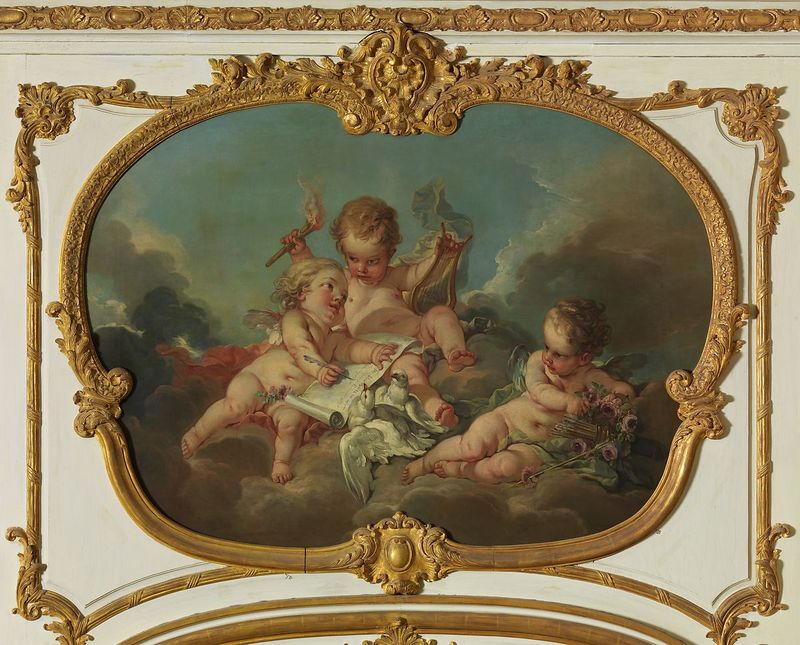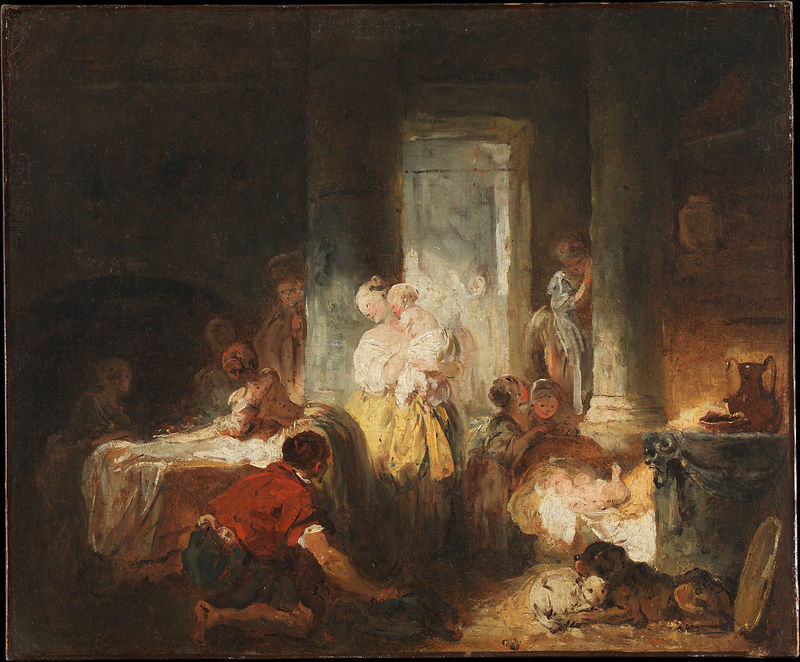The Decorative
Rococo aesthetic worked its way into every aspect of style in the eighteenth century, including fashion and architecture. Decorative motifs would adorn a room from top to bottom; “The ponderous ostentation of the Baroque ornamentation in sculptural embellishment and in its colourful appearance was made lighter and brighter, and any remaining straight line dissolved into sweeping scrolls” (Charles and Klaus 35). One characteristic design of the Rococo was the arabesque, which, “typically consisted of a sparse and highly symmetrical interlacing of scrollwork, foliage, and ornamental fragments, framing human and animal forms” (Sterret 42). Artists often used the arabesque on the intricately designed stucco walls, which framed paintings. Therefore, Boucher and Fragonard innovatively created paintings that complimented and even mirrored the complex decoration. These paintings often portrayed themes of little depth, and became more about aesthetic value than moralistic knowledge, reflecting the arabesque with organic shapes and unique composition.
As seen in the image above, Allegory of Lyric Poetry is an unconventional shape, and was made specifically to be installed amongst the gold, arabesque wall decor. Boucher utilizes aesthetic principles, like color and composition, in order to highlight the space that the painting inhabits. For example, Boucher selects lighter, pastel colors, like blues and pinks, in order to compliment the gold framing and white wall behind it. Furthermore, the shapes in the painting also reflect the decoration. The gold trimming is filled with curved, sweeping motifs, which creates a uniquely shaped space for the painting, reminiscent of an oval. To emphasize the arcs of the painting’s frame, Boucher depicts subjects that are organic and curvilinear. The outlines of the clouds, the plump curves of the cherub’s bodies, the curled hair, and the feathered doves all create an ornamental layering of undulating arcs and, therefore, reflect the arabesque decorations. By choosing to emphasize and mirror the decoration, Boucher designs a piece that becomes part of the decor. Furthermore, the painting makes no moralistic statement about its theme, poetry. Boucher simply symbolizes poetry through the pen and paper, the harp, and even the rose. However, despite the title “Allegory”, he omits a narrative about poetry that might lead to a religious or political discussion. Boucher demonstrates that the aesthetic value of the piece outweighs its moralistic value because it not only is made to compliment the decoration but also lacks deeper meaning.
Boucher’s Virgin and Child with Young Saint Baptist and Angels is one his few religious paintings; however, even while displaying subjects that commonly represent edifying themes, he still prioritizes aesthetic value because of how it compliments the decoration around it, and how he incorporates the pastoral. Much like Allegory of Lyric Poetry, the composition compliments the framing of the piece. The eye moves from the angels, to Mary, to the foliage around her. By using these angles, Boucher mimics the way that the eye moves through the arabesque designs on the frame. Moreover, he decontextualizes the figures and places them into Rococo by using a pastoral setting. Though there are inherent meanings behind Mary, Jesus, John the Baptist, angels, a lamb, etc., there is nothing about the way in which he painted them that added conviction or meaning to the scene, specifically in the lighting. Often, religious paintings use light and dark to portray meaning; however, the subjects are lighted evenly across the painting. If anything, he subverts their spiritual meaning by placing them in a setting that does not reference a particular narrative, but, instead, references the fantastical. By using composition that mirrors form, and placing moralistic subjects into a fantasy pastoral scene, Boucher prioritizes the piece’s decorative merit.
Fragonard painted Roman Interior in 1760 on a trip to Italy, and is one of his early paintings (Baetjer). Though in a clearly different style than his more quintessentially Rococo pieces, it demonstrates that during this time, “Painting addressed to this kind of looking is less concerned with capturing a subject and displaying it in its plenitude, than with captivating the viewer by extending, attenuating, and inflecting the impulse which draws the gaze into the image” (Sterret 2). In other words, artists were aiming to capture the eye and create something aesthetically pleasing, rather than portray something completely naturalistically. In this painting, Fragonard demonstrates “inflecting impulse” specifically through loose brushstrokes. By letting observers glimpse the hand of the artist, he creates visually compelling shapes which are lost in further blending. He prioritizes color and the shapes of the composition over technical perfection, which is a characteristic of much of his work. Fragonard prioritizes the general visual interest of his piece over accurate representation through loose brushstrokes.
Again, in Fragonard’s Fantasy Figure, he paints towards creating a pleasing decoration rather than portraying the subject in accuracy; this is shown through how he uses loose brushstrokes, details, and movement. Especially when observing the dress, one can see brushstrokes in every direction and value. Undoubtedly, he chose to capture the general shapes and colors of the clothing instead of taking every step to paint the fabric look like fabric. Fragonard also chooses to render details adorning the woman, such as the necklace, pearls, and lace. This detailing also makes the painting more engaging to examine. Lastly, Fragonard chooses to depict her in an active position instead of a more traditional portrait, where a subject might be sat still or standing. She is positioned extending her hand towards the viewer, fingering the pages of a book, and tilting her head. Through this positioning, Fragonard creates dynamic diagonals that imply movement and capture the eye of the viewer. All in all, Fragonard prioritizes the aesthetic value of the piece over accuracy.
The decorative nature of Rococo was in some ways freed artists to create new things. Artists no longer had to create art that had moralistic or deep meanings behind it, but could create art for the sole purpose of being enjoyed. However, the decorative nature of Rococo also was associated with luxury and wealth. Intricate decor, extravagant paintings, and a taste for style could only be afforded by the wealthy. Art that could be seen as freeing could just as easily be representative of an opulent, oppressive upper class and monarchy.



